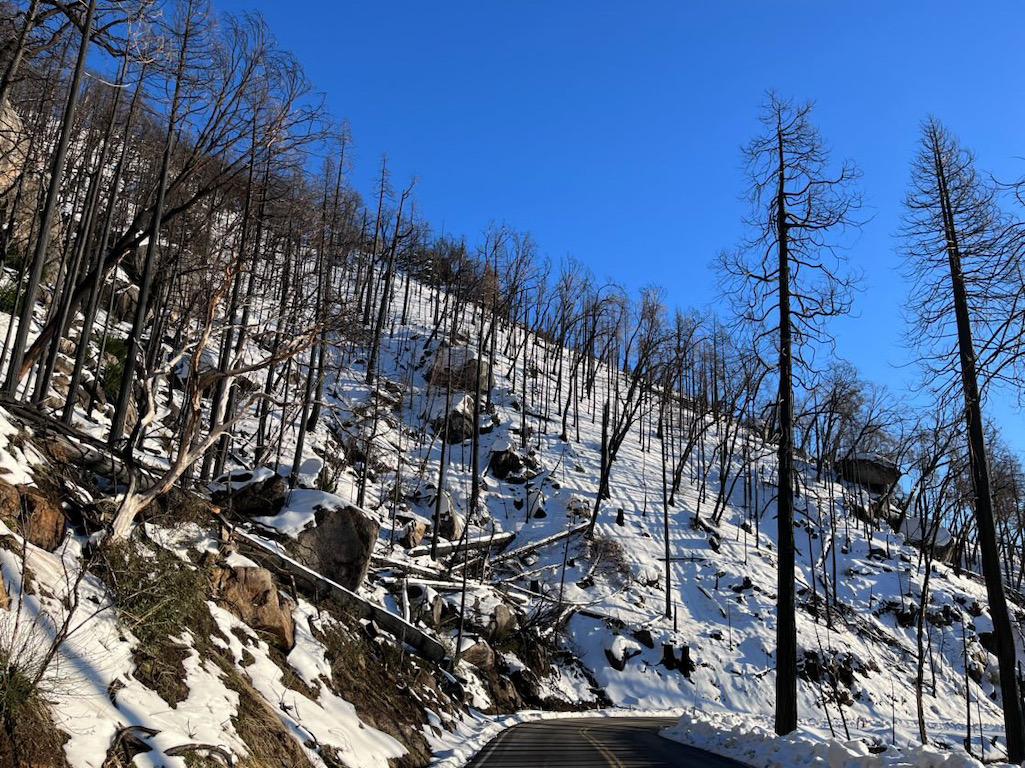
Burned trees from the 2021 KNP Complex wildfire along the Generals Highway/NPS,Emma Jornlin
Threats to visitors and park infrastructure posed by 12,000-15,000 "hazard trees" burned during the massive KNP Complex fire of 2021 at Kings Canyon and Sequoia national parks but still standing has the National Park Service formulating a plan to deal with them. The agency's preference is to remove tree hazards along roadways and the parks' developed areas within the fire's burn perimeter and then treat fallen debris around infrastructure and along roadways.
Public comment on the proposal and other alternatives is being taken through March 4. Details and comment space can be found here.
The KNP Complex was ignited by a large lightning event on the night of September 9, 2021. Despite immediate and aggressive suppression efforts, the two fires that initially comprised the complex merged in the coming days and burned rapidly through a large area of Sequoia National Park, and into Kings Canyon National Park, Sequoia National Forest, Bureau of Land Management lands, and lands under tribal, state, county, and private jurisdiction. The fire led to evacuation of many communities, closed public lands, and ultimately killed approximately 3-5 percent of the world’s population of mature giant sequoias
In the two parks the fire burned more than 88,000 acres.
Although the Park Service was able to restore access to major roads within the parks by removing some of the most imminent hazards, some roads remain closed following the KNP fire due to the density of tree hazards. Additionally, thousands of dead trees remain along roads open to public travel, which will become more dangerous over time if they are not removed.
An environmental assessment prepared for the work evaluated three approaches to reducing public safety hazards from the trees:
- Alternative 1, the "no action" alternative, which calls for no mitigation work.
- Alternative 2, which calls for tackling the hazard trees and then treating buffer areas around the developed footprint of park infrastructure and up to 80 feet wide along roads to remove logs and debris resulting from toppling trees or those hazard trees downed by crews.
- Alternative 3 calls for removing the hazard trees, but not creating and treating buffer areas.
According to park surveys, there could be more than 7,300 hazard trees along the Generals Highway corridor and more than 3,300 along the Crystal Cave Road in Sequoia National Park. Roughly 2,100 acres in the two parks would be involved in hazard tree mitigation, 922 acres in ensuing treatment work, and 61 linear miles of roadway, according to the EA.
The assessment analyzes options for treating fallen debris like pile burning, chipping and spreading on site, chipping and hauling from the parks, or hauling from the parks. Some wood may also be made available for public use via permit.
The work would be expected to protect road corridors that serve as fire breaks, evacuation routes, and access for firefighters and other emergency personnel. Compliance with the National Historic Preservation Act and other applicable laws is also being conducted.
If the Park Service's preferred alternative is chosen, work could begin as early as April.


